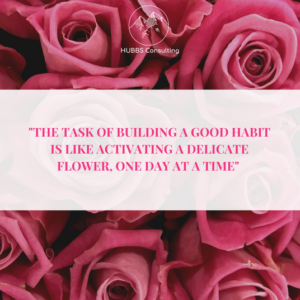Last week we learned all about how to break bad habits-this week’s focus is on how to build good habits! As James Clear says in his book, Atomic Habits (where most of the inspiration for last week and this week’s posts have come from), “the task of breaking a bad habit is like uprooting a powerful oak within us. And the task of building a good habit is like activating a delicate flower, one day at a time.” To achieve your goals, it is important to not only break the ineffective habits that are potentially sabotaging your ability to achieve your goals, but also cultivate good habits. Below are a few ways to help you create and maintain healthy habits.

Use Habit Stacking: It is likely that you already have several habits that you engage in daily, think: brushing your teeth, showering, eating dinner, etc. These may not seem like “habits” to you, but they are! The idea of habit stacking is to…you got it, stack a habit that you want to start doing on top of a habit that you already do! For example, if you want to get into an exercise routine or become more physically active, maybe you “stack” a 20 minute walk onto your dinner habit. Every night after you have finished dinner, you go for a 20 minute walk. Or, every morning after you brush your teeth, you do 20 sit ups. The idea is that you go from engaging in one habit immediately into the other habit. You can create your habit stacking strategy by using the sentence, “after [current habit] I will [new good habit].”
Use Implementation Intentions: According to James Clear, if you make a specific plan for when and where you will perform a new habit, you’re most likely going to follow through on that habit. An “implementation intention” is this specific plan that you make beforehand about when and where to act. Going back to the habit feedback loop discussed last week, all habits begin with a cue. The most common cues that trigger habits are time and location. Knowing this, the sentence you can use to create your own implementation intention is “when situation X arises [time/location], I will perform response Y [good habit].” Using the example of wanting to become more physically active you can use the cue of time (being situation X) to implement your walking routine (being response Y). Your implementation intention might be “when I finish eating dinner at 6:30pm, I will go for a 20 minute walk around the neighborhood.” OR, using a location cue, “when I enter the living room after having brushed my teeth, I will do 20 sit ups.”
Design Your Environment Intentionally: If you remember from last week, your physical environment can have a huge impact on whether you give in to temptations of ineffective habits, or cultivate healthy habits. Good news is, most of us have the ability to design our environment to fit our goals. If you want to make a habit a big part of your life, you will need to make the cue a big part of your environment. By placing your walking shoes, airpods, and water bottle close to the dinner table, this cue will help remind you of the good habit that you’re creating of going for a walk after dinner. Try sprinkling triggers in your surroundings throughout your day. This will make it more likely that you will think about your habit, and therefore more likely that you will engage in your habit. Can you place weights or a water bottle in your living room so that you will see them immediately after brushing your teeth? Or place a change of clothes by the front door so that as soon as you get home from work you’re reminded that you would like to go for a walk later in the evening. Make sure that you create your living and working environments so that they are full of productive cues and devoid of unproductive cues!
Join a Group of Like-Minded Individuals: One way to effectively build better habits is to join a group where your desired behavior is the normal behavior. Did you know that if your friends, family, partner, or other significant members of your life are overweight, your chances of becoming overweight are 57% higher? Scary, right? We as humans are drawn to behaviors that earn us respect, approval, admiration and status. If we belong to a group where unhealthy behaviors like drinking heavily, smoking, and binge eating are the norm, engagement in these types of behaviors will likely be encouraged. (Remember those college days when whoever could drink the most beers was given the most respect…..exactly). If you join a group where healthy behaviors like daily physical activity, healthy cooking, and other self-care activities are routine, you’ll likely begin to participate in these activities regularly. Try finding a neighborhood walking group, or joining fitness classes at your nearby gym.
Reward Yourself: I think we’ve all practiced this rule one way or another. We’ve probably all taken ourselves out for a treat (a new handbag, an ice cream cone, or a fancy dinner) for accomplishing something great, right? This is the same idea! The feeling of pleasure signals to the brain to repeat the action that brought it pleasure. This being said, we want the reward to serve our goals, or at least not cancel out the good habit we just engaged in. For example, we don’t want to reward ourselves for going on a 20 minute walk after dinner by coming home and eating a bag of potato chips. Instead, try rewarding yourself with something else you enjoy-maybe a TV show with your partner, or reading a good book. After doing your 20 situps, maybe you can reward yourself by watching your favorite morning show with a cup of coffee, or reading the newspaper. Whatever reward you choose, make sure that you are receiving immediate satisfaction from it to help ensure that you will want to continue engaging in your good habit.
Create a Streak: Streaks are powerful things! How many times have we sent a snapchat randomly just to keep that little fire emoji next to someone’s name? Or checked-in to another app just to keep your daily streak alive? I am definitely guilty of this. Use this same technique with yourself to be held accountable for engaging in your good habit! Start tracking each day that you perform your good habit-maybe it’s a check-mark on your calendar, or putting a marble in a jar. Whatever your tracking method of choice, make sure to keep your streak alive! **IMPORTANT** when you miss a day (it’s inevitably going to happen..and that’s OK!) don’t see this as an end to your habit. Instead, use the 2-day rule. Never miss 2 days in a row! You don’t go for a walk on Friday night? That’s fine, but make sure you go on Saturday!
Remember, we are a product of our habits. If you want a healthy and productive life, you must have healthy and productive habits! Hopefully after last week’s blog post you’ve started to become aware of, and abolishing your bad or unproductive habits so now you have plenty of time to build new ones that will help you reach your goals. If you need help implementing any of the above techniques to build better habits, give me a shout. Let’s work together to help you Build your Best Self!

